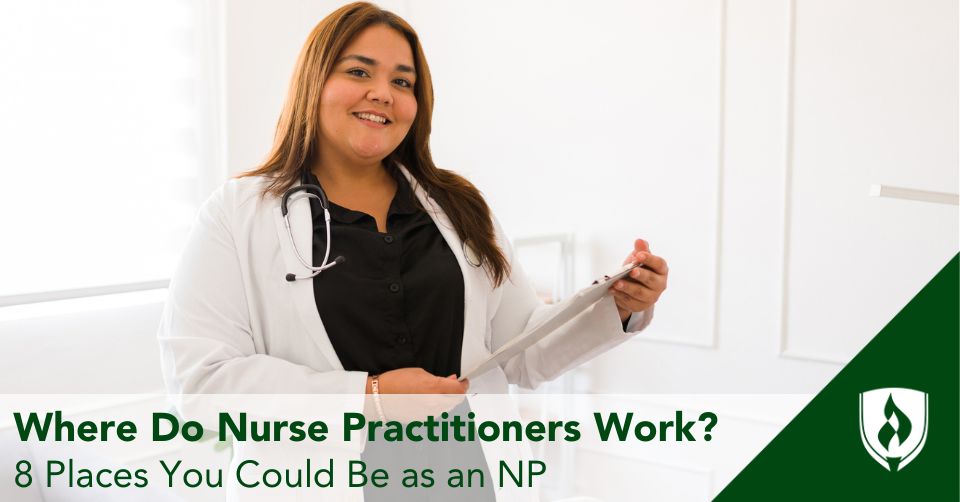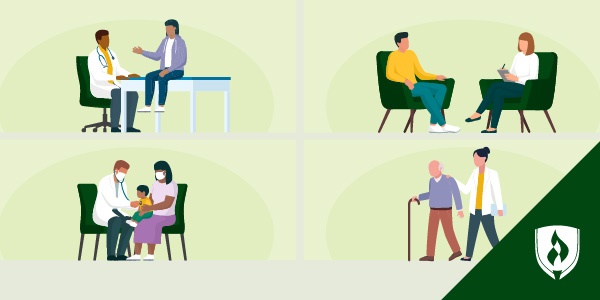
If working as a nurse is like flying on a commercial airline, then working as a nurse practitioner (NP) is like getting certified to fly your own, private helicopter. You go from squishing into roles with rigid parameters and no legroom, to a burst of autonomy and options.
You still have critical rules to follow—even more so. But as a nurse practitioner, you'll have the training to act with more independence.
Nurse practitioners are advanced practice registered nurses (APRNs) who can prescribe medication, diagnose conditions, order diagnostic testing (like blood labs or X-rays) and more.
But does that make much of a difference in terms of the working environment? Do nurse practitioners work on the same floors as registered nurses in the hospital? Do they work in long-term care facilities too?
You might be asking where do nurse practitioners work if you are looking to make a change from your current nursing role—or if you're a prospective nurse exploring all your options. In any case, read on! These advanced practice registered nurses have their own, unique career landscape in the nursing industry. And it's only growing.
Nurse practitioners work in...
1. Clinics and physician offices
Primary care is the most common destination for nurse practitioners by a fair margin. In 2022, 88% of nurse practitioners were certified in an area of primary care, and 70.3% of all NPs delivered primary care, according to the American Association of Nurse Practitioners (AANP®).1
Whether this looks like a family nurse practitioner handling basic medical care from a clinic or a nurse practitioner who specialized in a different area stepping in to prescribe medications and handle health care during shortages, it's important to know that there's lots of demand for an advanced practice registered nurse in private practices and clinics.
If you become a family nurse practitioner specifically, you will almost certainly work in a clinic location. Family nurse practitioners work in primary care services, prescribing medications, taking care of check ups and routine needs for infants, kids, adults and the elderly. Primary care providers might work in community clinics, local branches of a large healthcare system and any place people go for their regular health care services.
For some, working in these settings is a welcome relief from the odd hours and frenetic pace of hospital or long-term care facility roles. If that sounds like you, check out Clinic vs. Hospital Nursing: Which Setting Should You Work In? for a deeper comparison.
2. Mental health care facilities
After clinics and private practice, psychiatric mental health care is one of the most common places to see nurse practitioners. According to a 2018 survey, psychiatric mental health nurse practitioners (PMHNPs) made up approximately 26.3% of the of the psychiatric mental health workforce.²
As you can guess, demand for mental health services has only risen since then. Since nurse practitioners are one of few mental health professionals with the power to prescribe and manage medications, they are very needed.
If you become a psychiatric mental health nurse practitioner (PMHNP), you could work in multiple settings, including hospitals, mental health clinics and rehabilitation and addiction treatment centers. For more on that, check out What Does a Psychiatric-Mental Health Nurse Practitioner Do? The Role of a PMHNP Explained.
3. Hospitals
Nurse practitioners who love acute care can definitely find opportunity in hospitals and emergency rooms. The National Library of Medicine estimates that there were an estimated 25,000 nurse practitioners working in emergency care in 2023. They write that the presence of advanced practice registered nurses in emergency departments seems to be rising—but also that there's a lot of variance in what NPs do.
If you like the hospital setting, but gravitate to the less-acute side of patient care, working in medical/surgical areas can be a good option. Some studies indicate that nurse practitioners who work in rural hospitals tend to show more variety and versatility in the roles they take on since rural environments are often facing shortages.
Looking into job opportunities in rural locations can give you a good idea of how NPs are utilized in hospitals.
4. Long-term care environments and nursing homes
8.9% of nurse practitioners held a certification in Adult-Gerontology Primary Care in 2022.1 In this role, you could work in a clinic as well as nursing homes, elderly communities, home health services (going to the patients' homes) and even hospice care.
These NPs handle medications, order diagnostic tests and oversee treatment plans for elderly patients. It's a really good direction to go if you like the consistency of working with the same patients and their loved ones as they age. Specializing as an Adult Gerontology Primary Care Nurse Practitioner (AGPCNP) is the route you'd want to take for this one.3
5. Birth centers and women's health clinics
Nurse practitioners can specialize in midwifery, OB/GYN, neonatal or women's health. These focus areas set you up well for patient care related to the pregnancy, birthing, infant care (including acute care), breastfeeding and the post-partum process. These specialties are not part of Rasmussen’s MSN-NP program options.
You could provide primary care services for pregnant patients in a clinic, monitoring pregnancies and ordering lab tests and health screenings. You could work in the NICU with infants who need emergency care.
You could work in the birthing center, a hospital or another outpatient location devoted to birth, helping people through the labor and delivery process. And you could also work in a women's health clinic, assisting with family planning, birth control and sexual and reproductive health. So many options!
6. Pediatric healthcare settings
As an advanced practice nurse, you could also specialize in caring for kids. A pediatric primary care nurse practitioner can work in health care settings dedicated to children. That could be in a children's hospital or specialized location, like children's oncology. Or it could be in a clinic where you'll do wellness exams, oversee immunizations and keep an eye on the healthy growth and development of children.
If you've never worked in peds, take a look at I Love Pediatric Nursing: Nurses Share What Makes It Worthwhile to see what nurses like about it.
7. Public health departments and consulting roles
The nurse practitioner role is most often a clinical role—actually working with patients. But nurses have a tendency to find further ways to influence health care as a whole. That's even more true as they advance through their nursing career.
Public health departments can employ nurse practitioners to help advise a city or state in their public health policies. In order to work in public health, nurses might need additional training or experience.
Nurse practitioners can also step into advising and consulting roles for nursing associations, nursing boards, universities and healthcare system administration—all of which can allow NPs to help shape the future of nursing.
8. Their own private practice
If you want to become a primary care provider for any specific patient population, becoming a nurse practitioner can allow you to branch out and establish your own practice.
This can be very appealing if you'd prefer to offer a different model of patient care than most healthcare employers allow. For example, some nurse practitioners are recognizing how inaccessible 9-5 clinical hours are for people who can't get away from their jobs or pull their kids out of school during those times. Opening their own practice allows them to set the hours.
Maybe you want to be able to spend more time on each patient—develop stronger ties. Or maybe you'd like to integrate mental health care into family health or focus more on lifestyle and holistic patient education. Whatever your dream would be, opening your own private practice can be a way to give that dream more power.
Most states (27 and Washington D.C.) allow nurse practitioners full practice authority, but it's very important to note that some do not. Many states also have limits or changes to the practicing authority to look into.
This practice authority map from the American Association of Nurse Practitioners® can provide you with detailed state information.
Get specific with your nursing career
One of the best things about working as a nurse practitioner is the power you have to focus your nursing on what matters most to you. Just like other nursing roles, nurse practitioners can work in many different settings with many different schedules and roles.
Nurse practitioner employment is projected to change by 45% from 2022-2032, according to the Bureau of Labor Statistics.4 That makes them the second-fastest growing occupation in the country. Nurse Journal writes that this projected growth is likely due to how healthcare systems are tapping NPs for more expanded roles, trying to bridge gaps due to physician shortages.
As we continue to explore what NPs can do, one thing is certain—these nurses are finding ways to shore up gaps in accessibility and care wherever they go.
It's an exciting time to be an NP. And part of the fun is the chance to be the specific kind of nurse you want to be. Check out Nurse Practitioner Specializations: A Newcomer’s Guide to see which specialty might appeal to you most.
AANP® is a registered trademark of American Association of Nurse Practitioners, Inc.
American Association of Nurse Practitioners® is a registered trademark of American Association of Nurse Practitioners, Inc.
1American Association of Nurse Practitioners®, NP Fact Sheet, (accessed April 2024), NP Fact Sheet (aanp.org).
2Aparna Kumar, PhD, CRNP, Anne Kearney, MSN, CRNP, Katelin Hoskins, PhD, CRNP and Anita Iyengar, DNP, MSN, CNS, The role of psychiatric mental health nurse practitioners in improving mental and behavioral health care delivery for children and adolescents in multiple settings, (Jul.18, 2020), https://www.ncbi.nlm.nih.gov/pmc/articles/PMC7547148/#R4
3Nurse Practitioner specializations at Rasmussen University are not eligible for participation in Title IV federal student aid programs
4Bureau of Labor Statistics, U.S. Department of Labor, Occupational Outlook Handbook, Nurse Anesthetists, Nurse Midwives, and Nurse Practitioners, (accessed May, 2024), Nurse Anesthetists, Nurse Midwives, and Nurse Practitioners : Occupational Outlook Handbook: : U.S. Bureau of Labor Statistics (bls.gov)




